2016 MXA RACE TEST: EVERYTHING YOU NEED TO KNOW ABOUT THE KAWASAKI KX450F
Q: FIRST AND FOREMOST, IS THE 2016 KX450F BETTER THAN THE 2015 KX450F?
A: If you are a loyal KX450F racer, this is the fulfillment of all of your dreams. It is a lighter, thinner, lower, sleeker and better handling bike than any 450cc four-stroke that Kawasaki has ever made. Gone are the days of excessive girth.
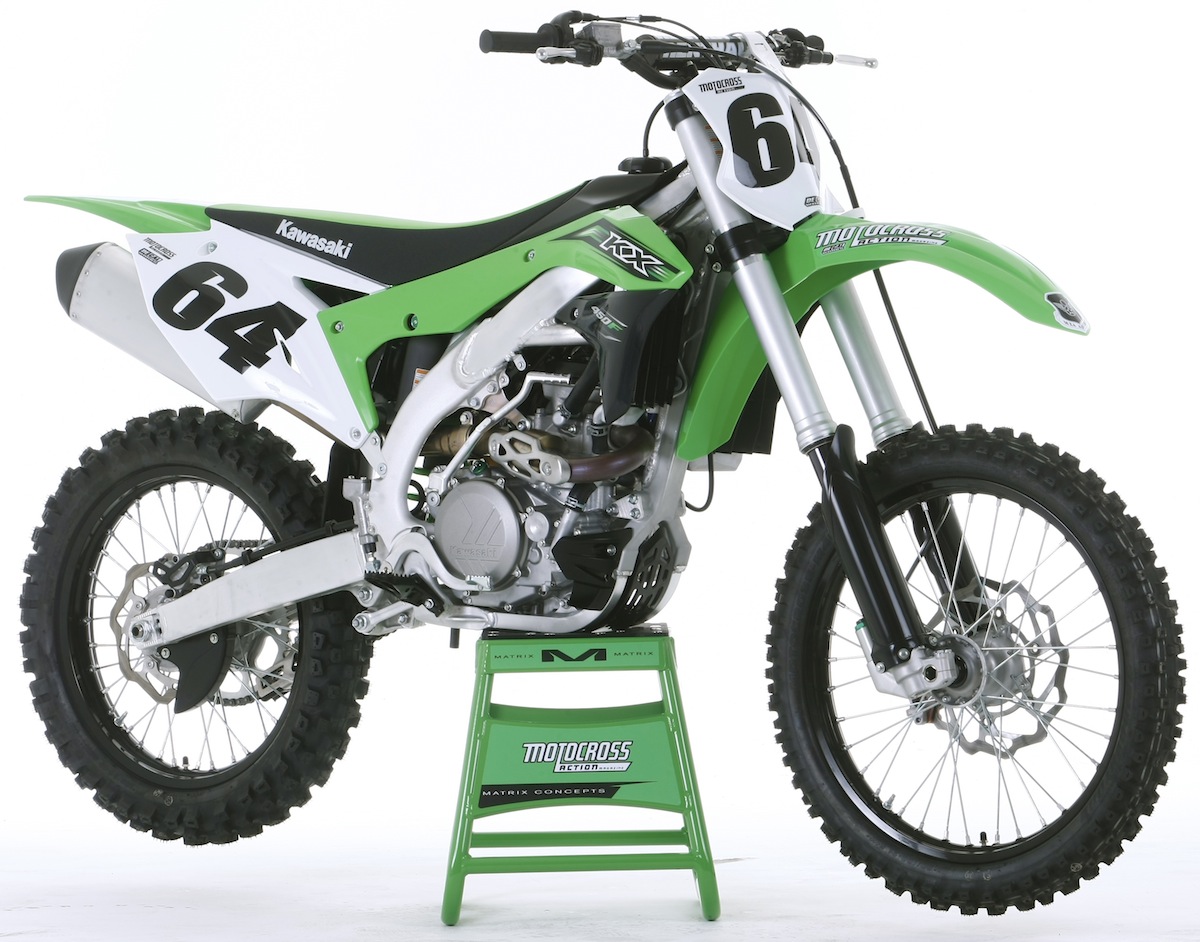 After years of bing big and bulky, the Kawasaki engineers put the KX450F on a diet. The new downsized Kawasaki is a big improvemrnt in fit and feel.
After years of bing big and bulky, the Kawasaki engineers put the KX450F on a diet. The new downsized Kawasaki is a big improvemrnt in fit and feel.
Q: WHAT DID KAWASAKI CHANGE ON THE 2016 KX450F?
A: Here is the quick list of a bike that has a long list of changes.
(1) Engine: The crankcase casting has thinner walls, while providing more rigidity and strength. The cylinder has been offset 8.5mm forward to reduce decompression braking. A new crankshaft balancer and drive gears save 2.3 ounces. The piston crown has been reshaped to match the straighter intake port shape, while the compression ratio remains at 12.8:1.The titanium intake valves have a slimmer throat angle and larger air intake area. The cams are 0.5 ounces lighter and the intake cam timing is advanced 2-degrees. The 43mm Keihin throttle body is now direct-connect (which is 3.5 ounces lighter than the previous double-pulley throttle body).
(2) Transmission. The five-speed tranny went on a diet by slimming excess fat off the gears and using larger input and output shafts with thinner walls. The overall weight savings is 9.2 ounces.
(3) Exhaust. The head pipe has a resonance chamber tucked in behind the heat shield and the sound level has been reduced by 2 decibels.
(4) Electronic aids. The 2016 KX450F has launch control, three plug-in ECU couplers and a hand-held mapping tools with 7 preset maps. The mapping tool eliminates the previous need for a laptop computer and 12-volt battery. It works on all KX models back to 2009.
(5) Frame. Thanks to forged parts, a revised downtube and 6mm narrower spars the weight of the aluminum perimeter frame is reduced by 14.1 ounces. Thanks to thinner hyrdroformed spars and increased rigidity in the cast pieces, the swingarm is not only torsionally more rigid, but also 7.8 ounces lighter. The gas tank fits lower in the frame and holds 1.66 gallons of fuel. The radiators are canted forward at 10 degrees to narrow the profile of the bike at the shrouds by 1.2 inches.
(6) Suspension. The forks are Showa SFF Air TAC forks built to Kawasaki specification and are different from the SFF Air TAC forks on the Suzuki RM-Z450. By using thinner inner fork tubes the weight of the Showa forks has been reduced by 11 ounces. Kawasaki supplies each owner with a digital air pump. The Showa rear shock has revised valving and a lighter rate shock spring (from 53 N/m to 52 N/m). The new spring is 5.5 ounces lighter. Additionally, there is a new rising rate linkage that saves 6.0 ounces.
(7) Plastic. All the plastic parts, including the fenders, radiators shrouds, engine guards and front number plate follow the “edge styling” school of design. The plastic parts are 4.9 ounces lighter this year.
(8) Weight savings. Kawasaki shaved 7.5 pounds off of the 2015 KX450F’s weight with 4.4 pounds attributed to the engine and 3.1 pounds to the chassis.
Q: WHAT DOES THE 2016 KX450F WEIGH?
A: As amazing as it may seem, even with Kawasaki’s Jenny Craig diet and 7.5 pound weight loss, it did not come out of the weigh-in as the lightest 450cc motocross bike in 2016. That is largely because the 2015 KX450F weighed almost 239 pounds—thus, the slimmer and trimmer 2016 model hits the MXA scales at 231 pounds. A year ago, this would have been the lightest bike by a couple pounds, but in 2016 the KTM 450SXF weighs 227 pounds and the Husqvarna FC450 weighs 229 pounds. As a consolation prize, the KX450F beats the Honda CRF450 by 2 pounds, the YZ450F by 7 pounds and the RM-Z450 by 9 pounds.
 Don’t let the horsepower numbers depress you. The KX450F has a very pleasant style of power.
Don’t let the horsepower numbers depress you. The KX450F has a very pleasant style of power.
Q: IS THE 2016 ENGINE MORE POWERFUL THAN THE 2015 ENGINE?
A: Yes and no. Yes, it has better low-to-mid power, specifically from 5500 rpm to 7000 rpm, and a stronger over-rev from peak to sign-off (in the 9200 rpm to 11,300 rpm range). No, it is not appreciably more powerful on total horsepower. The 2016 KX450F makes 55.43 horsepower to last year’s 55.07 horsepower. It should be noted that it has been a couple years since the KX450F was the king of the horsepower wars.
Over the past few years Yamaha, KTM and Husqvarna have eclipsed it by 2 to 3 horsepower. In fact, at 6000 rpm the KX450 gives up 2.6 horsepower to the KTM 450SXF. At 8000 rpm, the KX450 gives up 1.4 horsepower to the KTM 450SXF. At 10,000 rpm, the KX450 is 5.0 horsepower behind the orange bike. Plus, when we analyzed how long the Kawasaki KX450F ‘s engine stayed above 50 horsepower, the range was 2800 rpm (from when it first cracked 50 hp to when it couldn’t maintain it). For comparison, the 2016 KTM 450SXF stayed above 50 horses for a 4300 rpm range. That doesn’t mean that the 2016 KX450F engine is slow. It isn’t. It also doesn’t mean that it is blazing fast. It isn’t. What it has in spades is a usable low-to-mid power that can be made to work without being white knuckle fast.
Q: WAS IT ALL SUNSHINE & ROSES WITH THE KX450F ENGINE?
A: No. It pinged. And when it didn’t ping it suffered from some of the loudest popping on deceleration we’ve every heard. The decel pop was so irritating that riders finishing behind us in a motos would come over to complain. Decel pop is normally caused by an air leak or overly lean jetting. We had Kawasaki come with us to attempt to iron out the decel pop out. We tried all seven pre-programmed maps including the rich ones, lean ones, advanced ones and retarded ones — no go. We tried several maps that Kawasaki especially programmed for our bike — no go. Finally, we put the map back to stock and tried all three plug-in couplers. The only one that tamed the pinging and popping was the black coupler. The other two couplers belched, especially when the engine got hot. The black coupler did the trick, but the downside was that the black coupler is the mellow map — and with it you get a mellower power delivery—albeit a much less irritating one.
The overall power output isn’t impressive when compared to what KTM and Yamaha produce—especially on top. Luckily, it just feels slower than it is. We would recommend testing all three plug-in couplers to see whether or not your mapping suffers or not. If your conditions favor the white map, run it. Kawasaki admitted that the bike did pop, but also said that they had production units that ran fine.
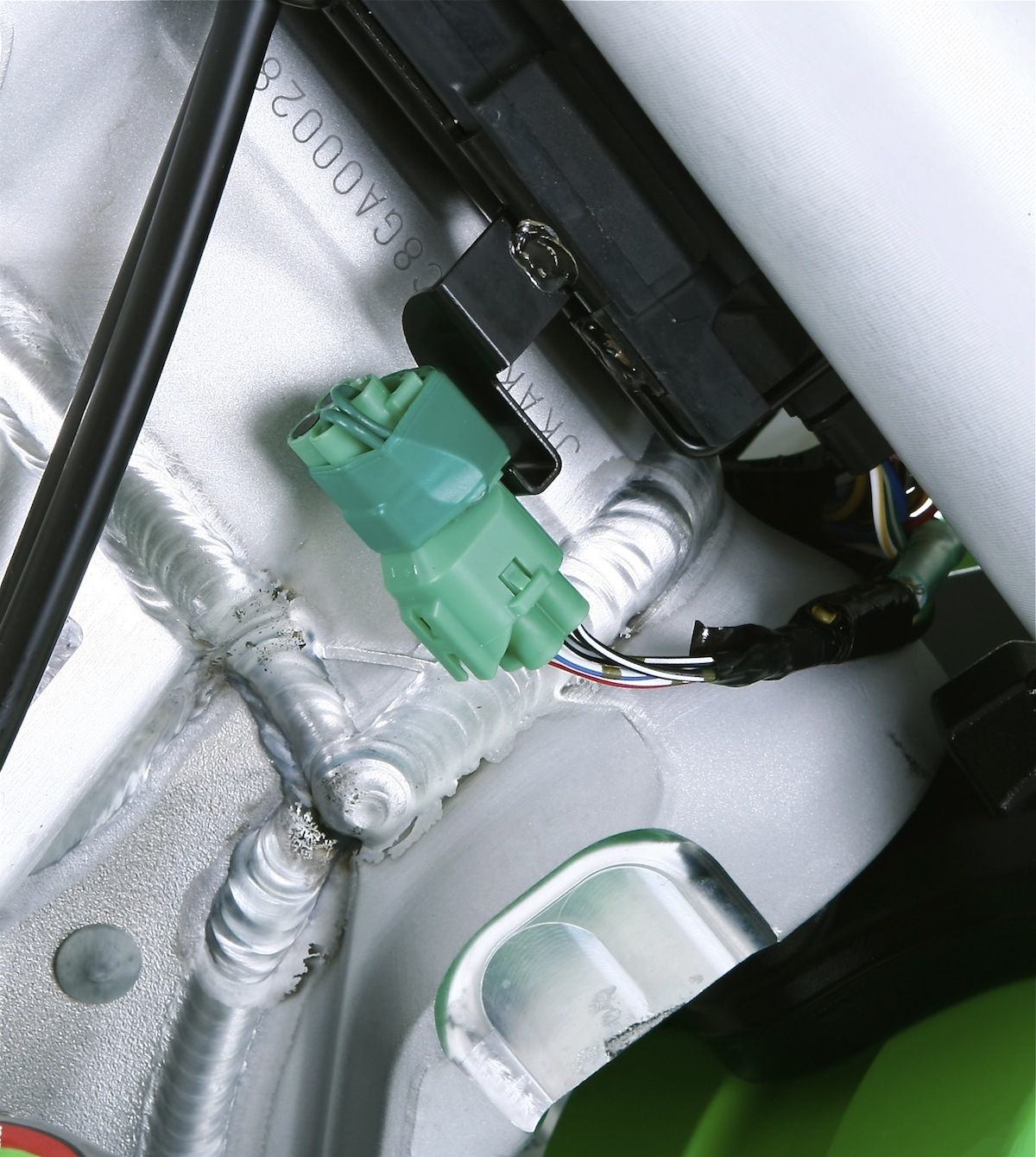 The 2016 KX450F comes with three plug-in couplers. The green couple (above) is the stock map.
The 2016 KX450F comes with three plug-in couplers. The green couple (above) is the stock map.
Q: HOW GOOD ARE THE 2016 KX450F BRAKES?
A: The answer to this question is found in a brief history of KX pucker power.
In our 2011 KX450F test we wrote, “A bike this fast and heavy needs the best brakes it can get—unfortunately the Kawasaki brakes are not crisp, powerful and accurate.”
In our 2012 KX450F test we wrote, “If this bike weighed in at the AMA minimum, maybe, just maybe these spongy brakes would stop it—but with the 2012 KX450’s ample horsepower and girth these brakes are 98-pound weaklings.”
In our 2013 KX450F test we wrote, “As a credo, the company that makes the most powerful engine should also make the most powerful brakes.”
In our 2014 KX450F test we wrote, “These old-school brakes won’t to stop 239 pounds of runaway locomotive.”
In 2015 KX450F test we wrote, “Thankfully, Kawasaki upsized last year’s 250mm front brake rotor to 270mm for 2015. Good stuff, but are they as good as KTM’s 260mm Brembo brakes? No!”
In 2016 we will stick with what we said in 2015. The 270mm KX450F front brake is much better than the old 250mm front brake, but just bolting on a big rotor isn’t enough to compete with Brembo’s totally integrated package of rotor, caliper and master cylinder.
 The radiators are canted forward by 10-degrees to allow the radiator shrouds to tuck in close.
The radiators are canted forward by 10-degrees to allow the radiator shrouds to tuck in close.
Q: HOW GOOD ARE THE 2016 SHOWA SFF-AIR TAC FORKS ?
A: Make no mistake about it, Showa Air TAC forks are most complicated, complex and difficult forks to live with ever devised to torment a motocross racer. Between their three different air pressures, 22 compression settings, 20 rebound choices and four different oil height adjustments, a rider has 420,000 tuning combinations to work with. And one change to any of the adjusters reconfigures the relationship between the inner, outer and balance chambers to the point that you’ll want to pull your hair out without removing your helmet.
That said, these are really good air forks. We never thought we ever say that about TAC forks. Whether we were setting them up for an AMA Pro or a portly Vet Novice, we got them in the sweet spot quickly and with little or no hassle (in sharp contrast to the SFF TAC forks on the 2016 Suzuki RM-Z450). Of course, the air pressure and clicker settings for a Pro and a Novice are in different zip codes, but we will provide you with the ballpark numbers to help you find the perfect setting. Kudos to Kawasaki for updating and upgrading their valving specs—because last year their recommended air pressures were so far off that they would bottom if they hit a Snickers’ wrapper on the way to the starting line. This year’s stock setup in spot on. The best thing about the 2016 SFF-Air fork is that we were able to find air pressure settings that really worked. Something that mystified and evaded many 2015 KX450F owners.
What’s the worst thing about SFF Air? The average rider doesn’t have the patience, time or interest in living vicariously through his air pump. We have met some racers who gave up and traded their TAC forks for older coil spring forks. Others who chased air pressure settings without the minimal understanding of the interplay between the inner air chamber and the balance chamber (hint, they work in opposition to each other). We’ve also met a few who stopped checking their air pressures months ago. Nobody ever asked for labor intensive forks, but they got them. Now, you might say that great forks often require constant care, but that is negated by Kayaba’s fabulous SSS coil spring forks. Set ’em and forget ’em.
Q: HOW DOES THE 2016 KX450F HANDLE?
A: Would it sound rude to say that the 2016 Kawasaki KX450F handles nothing like a Kawasaki KX450F? All previous KX450F’s were stodgy, reluctant, upright machine that turned via brute force. There was nothing intuitive about KX450F handling from 2006 to 2015. You had to manually steer it into a corner, unless there was a berm, and then correct the steering input at the midway point when the KX450F stood up. Not so with the 2016 KX450F. It wants to turn.
Maybe it wants to turn a little too much, as every test rider complained about looseness on the entrance to corners, but we will take a little front end wag to get a green machine that doesn’t fight you when you try to make a direction change. Thanks to its lighter weight, flatter seat, narrower tank and more balanced chassis, this is the anti-KX450F that we all dreamed of. It will erase the old memories of the heavy ocean liner that needed a harbor master and a tug boat to get around a corner. Not perfect—but far from flawed.
Q: WHAT DID WE HATE?
A: The hate list:
(1) Plastic. This isn’t Kawasaki’s first rodeo with brittle plastic. They have a history with front fenders, front number plates and fork guards that splintered when roosted. The extra-long radiator shrouds on the 2016 KX450F crack on the left side (just rear of the gas tank) and crackle on the right side around the bolt holes.
(2) Sound. Kawasaki claims to have knocked 2 decibels off for 2016. If that’s true it has reduced the sound to painfully loud as compared to last year’s ear bleeding loud. Surprisingly enough, it is very quiet when held to the amateur-required SAE 94 decibel sound test (at 4500 rpm).
(3) Rear brake pedal. Old school racers who want to run their brake pedal low will have to hacksaw off some of the plunger’s threaded rod. If you don’t, you will burn up the rear brake in a few laps. Riders who run their pedals high will have no issues.
(4) Ignition. Just like last year, we had come mapping problems.
(5) Clutch. The stock KX450F clutch pack is marginal. If you are a clutch abuser, you will eat this clutch in short order. Stiffer clutch springs can save the day.
(6) Black coupler. Because of the detonation problem we switched from the stock green map coupler to the mellow black coupler. At least until you can find a richer map that works. The black coupler eliminated the decel pop (is is a repeat of one of the seven pre-programmed maps), but the mellow map made the power mellower. Who would have thunk it?
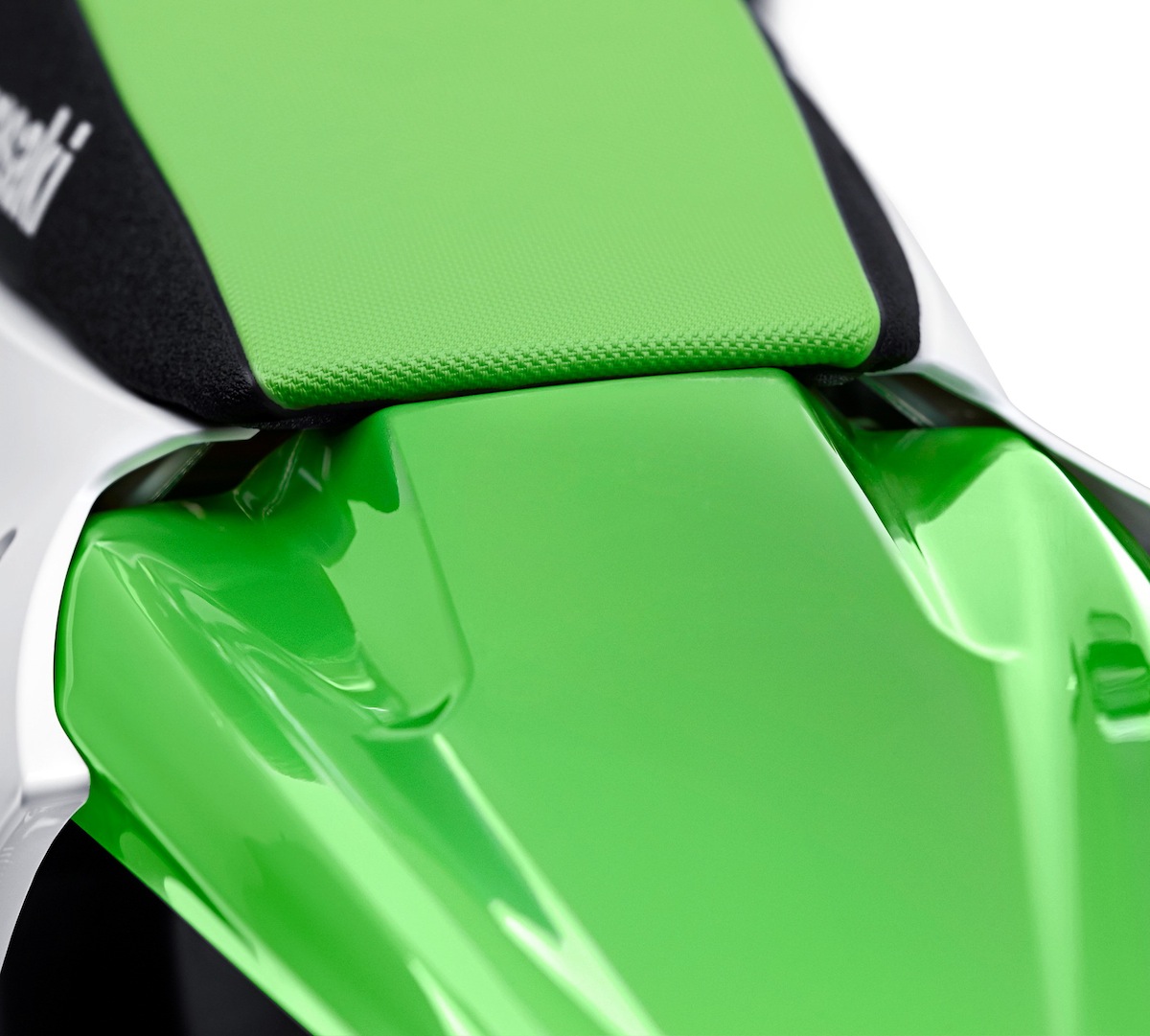 Given the massive opening in the side of the KX450F airbox, these petite air vent under the seat seem like fluff. But, they look cool.
Given the massive opening in the side of the KX450F airbox, these petite air vent under the seat seem like fluff. But, they look cool.
(7) Airbox. We can’t say that we are wild about the freestyle-like airbox vents on both sides of the KX450F’s airbox. They are large enough to allow massive amounts of air into the engine, but also small rodents, water and dirt. We do like the look of the rear intake channels built into the rear fender.
(8) Chain guide. If history is any judge, the stock chain guide will get chewed up faster than a $3 steak special at Sizzler. We suggest contacting T.M. Designworks at (541) 772-4161 for their indestructible chain guide kit.
(9) Power. We miss the halcyon days of 2012 when the KX450F made the most power in the 450 class. For 2016 it ranks fourth in peak horsepower and delivers a very deliberate but, uninspiring style of power.
 Kawasaki joined the plug-and-play reprogramming movement with their very comprehensive mapping tool. It, however, is priced out of the average rider’s ballpark at $700.
Kawasaki joined the plug-and-play reprogramming movement with their very comprehensive mapping tool. It, however, is priced out of the average rider’s ballpark at $700.
Q: WHAT DID WE LIKE?
A: The like list:
(1) Launch Control. We run it on concrete and hard-pack starts, but not on loamy starts. It functions in first and second gears and is turned off when you shift to third.
(2) Mapping tool. Most MXA test riders admire the $291.00 Yamaha GYTR programming tool because it is easy to use, simple to understand and similar to a Playstation. Kawasaki’s hand-held mapping tool is much more complicated, but it gives an aspiring hacker all the tools he’ll ever need to store up to 200 distinct maps. However, it costs a startling $699.95.
(3) SFF Air TAC forks. The KX450F air forks surprised us. How so? They actually worked right out of the showroom floor. Will wonders never cease?
(4) Air pump. Kawasaki gives every KX450F buyer a free 0-300 psi digital air pump. You will wear it out.
(5) Gearing. We ran the stock gearing for almost every situation.
(6) Foot pegs. The KX450F foot pegs can be moved down 5mm if you so desire. No MXA test riders have ever desired to do so, but it is reassuring to know that if we hit a growth spurt we could stretch out a little.
Q: WHAT DO WE REALLY THINK?
A: Love the forks, weight and smaller dimensions. Like the handling and power. Hate the clutch, mapping and rear brake pedal. We can fix the glitches.
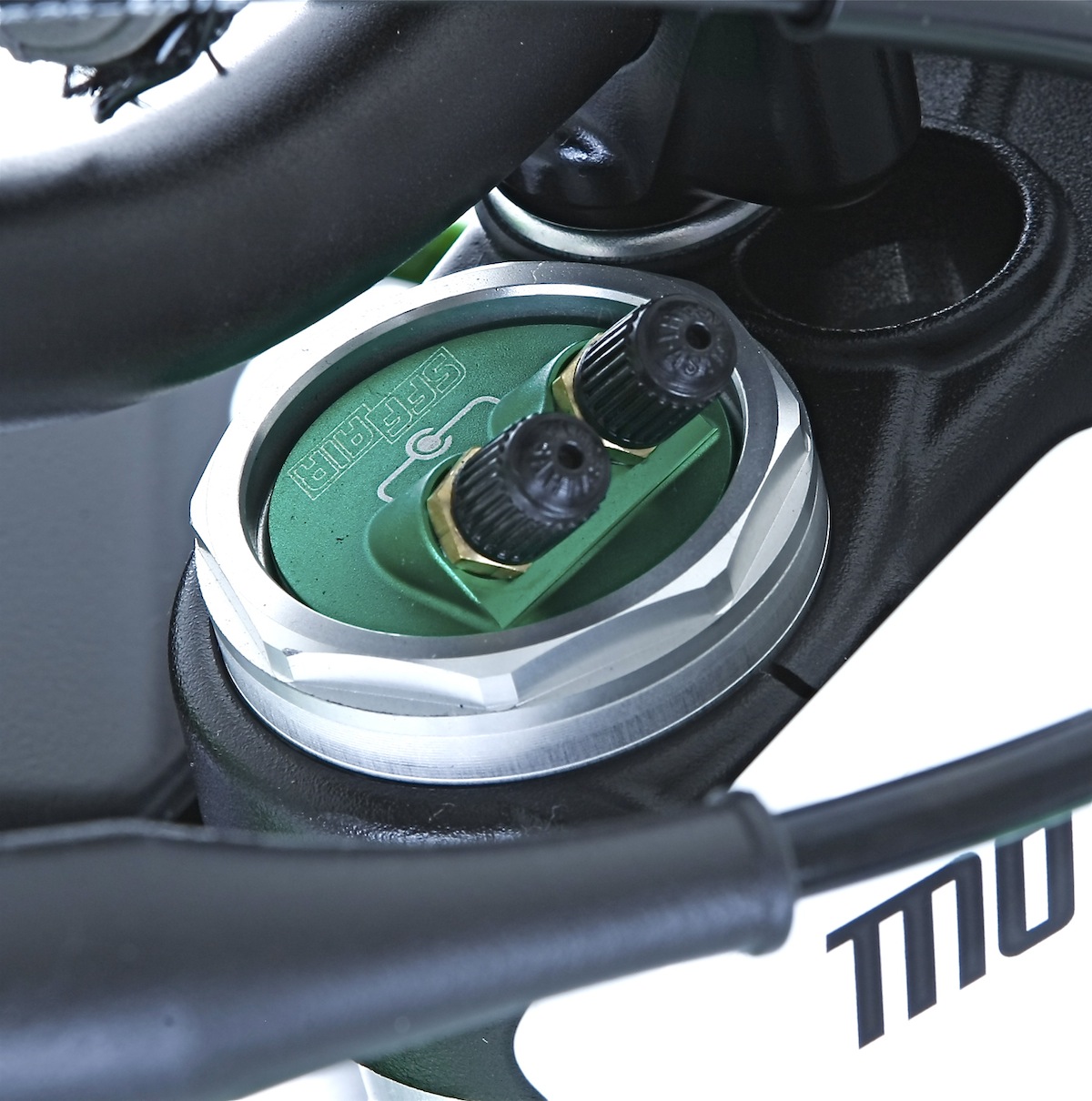 There is a curse upon the land. It’s name is air forks. But, as curses go, the KX450F’s Showa TAC forks are the best we’ve tested.
There is a curse upon the land. It’s name is air forks. But, as curses go, the KX450F’s Showa TAC forks are the best we’ve tested.
MXA’S KAWASAKI KX450F SETUP SPECS
This is how we set our 2016 Kawasaki KX450F up for racing. We offer it as a guide to help you find your own sweet spot.
SHOWA SFF-AIR TAC FORK SETTINGS
The inherent problem with air forks is that they are speed sensitive. A faster rider will run higher air pressures in the inner and balance chambers than a slower rider. Which means that suggested air pressures must always have an asterisk attached that is based on the rider’s speed, weight and track design. we have provided the air pressure settings below for Vet, Intermediate and Pro riders. These are the setups we ran on the 2016 Kawasaki KX450F for hardcore racing:
Inner spring rate: 160 psi (Vet), 174 psi (Intermediate), 185 psi (Pro)
Outer spring rate: 14.5 psi
Balance spring rate: 175 psi (Vet), 203 Intermediate/Pro)
Compression: 13 clicks out (9 clicks out)
Rebound: 13 clicks out
Fork leg height: 5mm up
Notes: As a general rule, we always ran more air pressure in the balance chamber than in the inner chamber. This lets the forks settle and not ride as high in their stroke—which helps the KX450F turn better.
SHOWA SHOCK SETTINGS
The shock was a surprise. It worked well from day one and although we went out on several settings and ran the race sag at a relatively low 104mm, we liked the improvements to the rear suspension. We recommend this shock setup on the 2016 Kawasaki KX450F (stock specs are in parentheses):
Spring rate: 5.2 N/m
Hi-compression: 2-1/4 turns out (1-3/4 turns out)
Lo-compression: 15 clicks out (13 clicks out)
Rebound: 11 clicks out (12 clicks out)
Race sag: 105mm
Notes: The shock was easy as pie to set up. The rear end had minimal wallowing and worked very well under braking in chop and square-edged bumps.
MXA’S 2016 KAWASAKI KX450F VIDEO



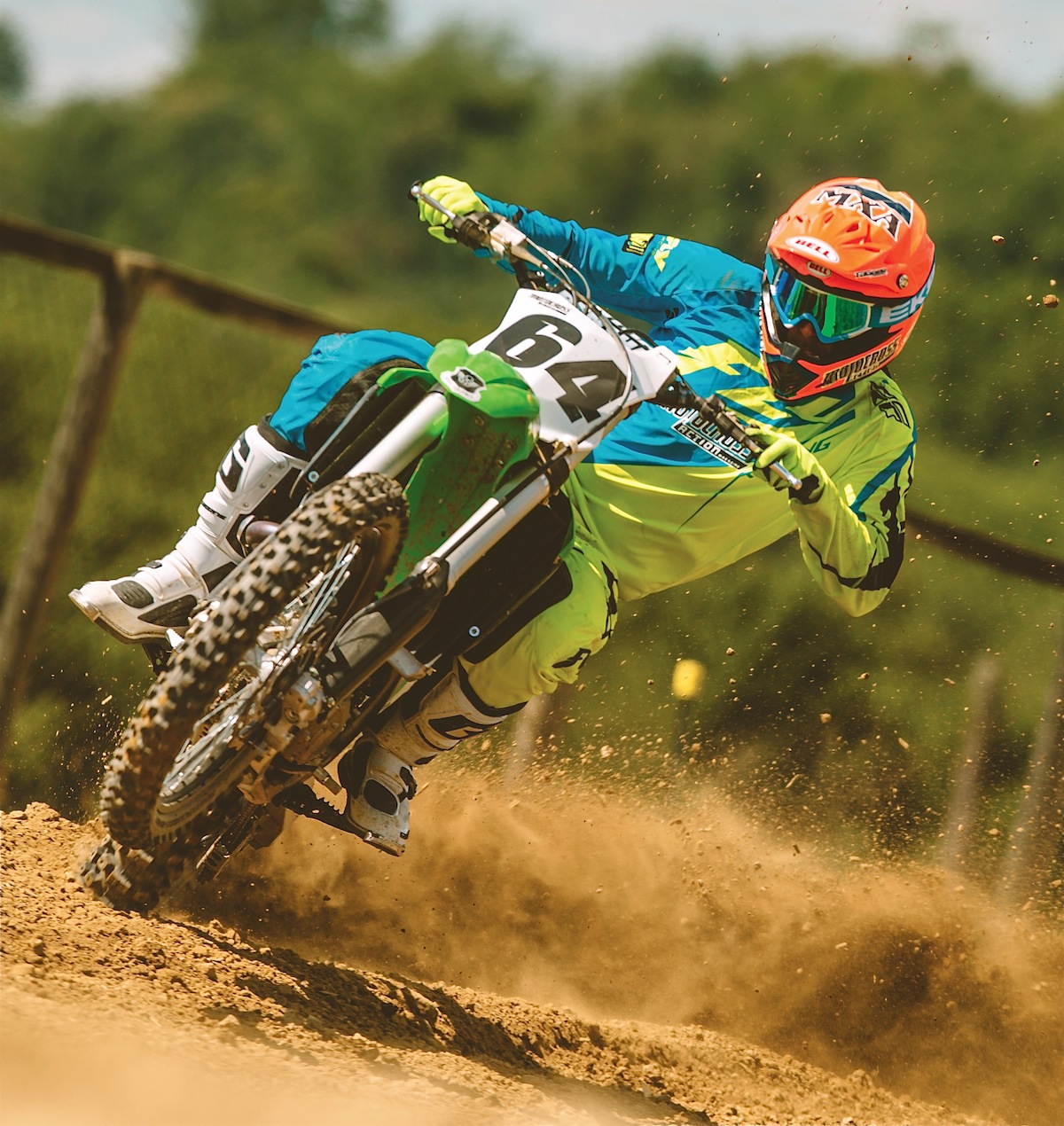

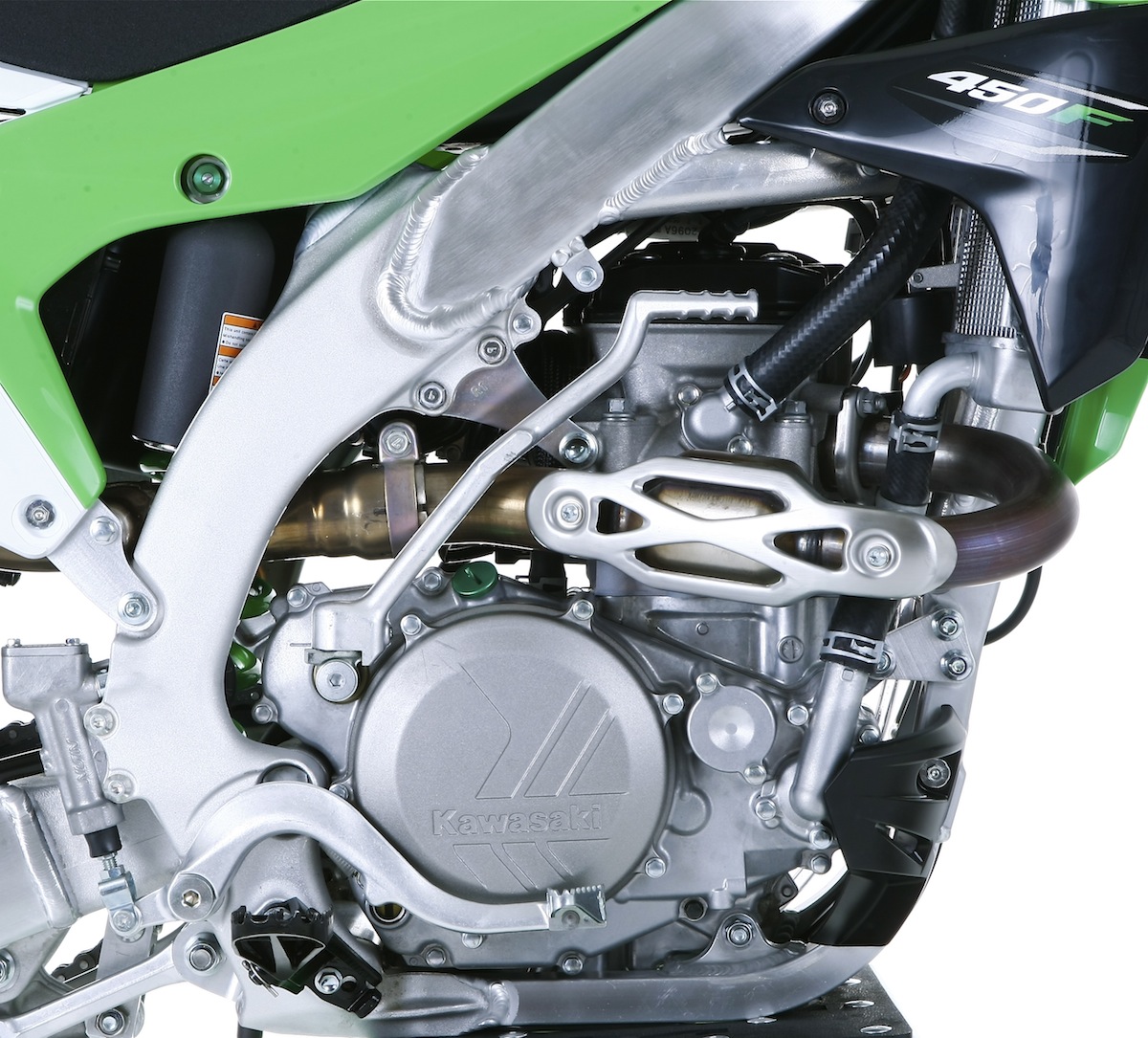

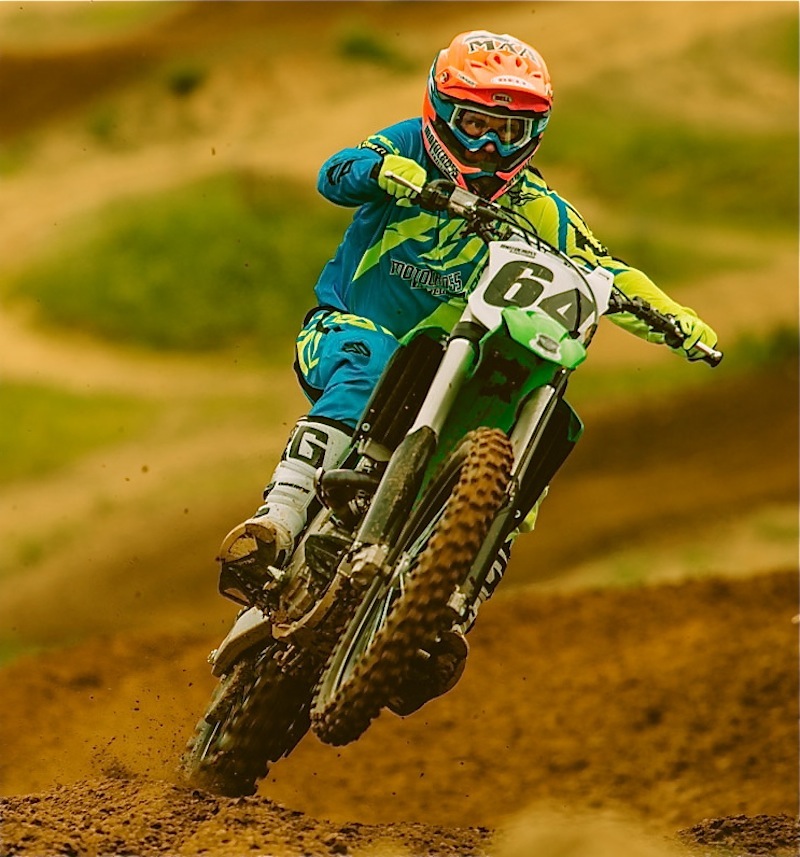
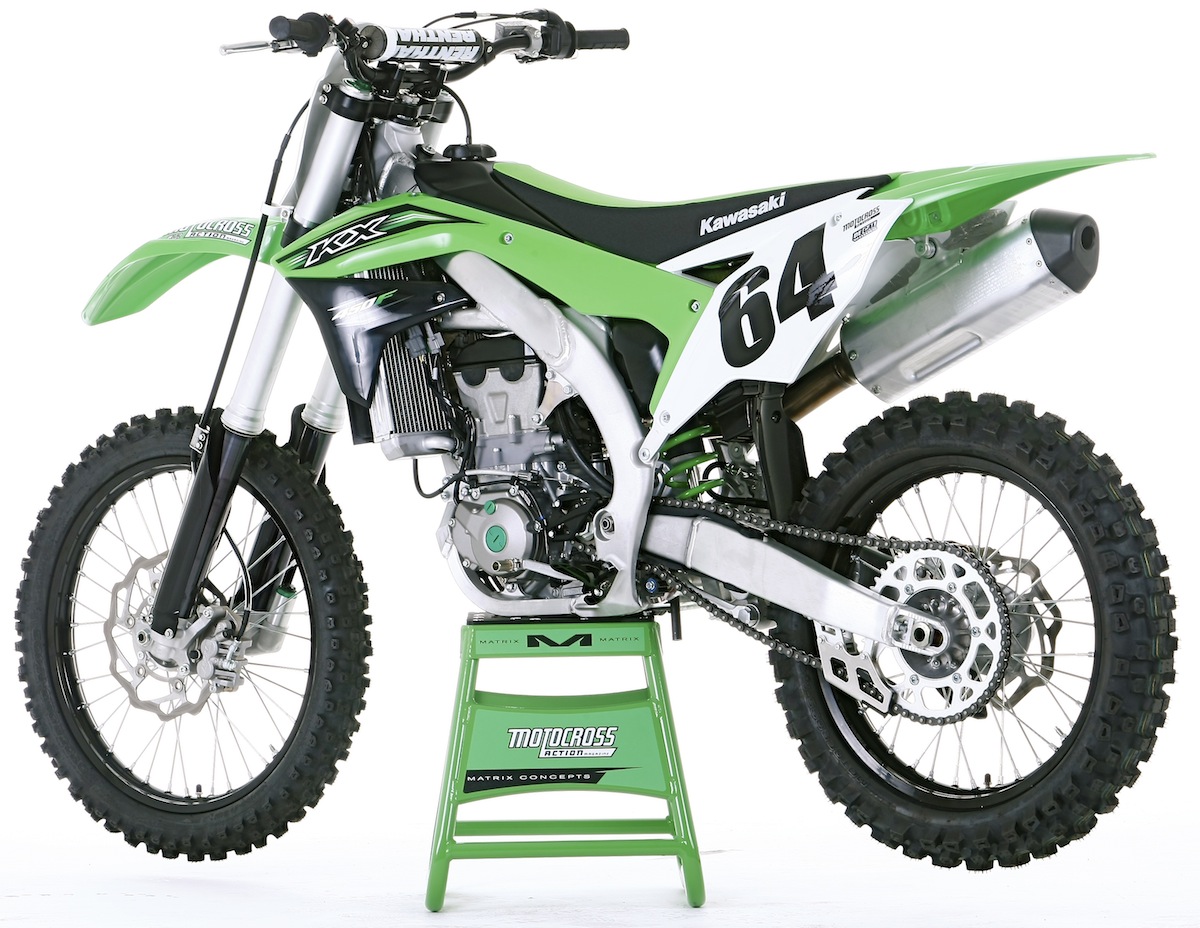



Comments are closed.